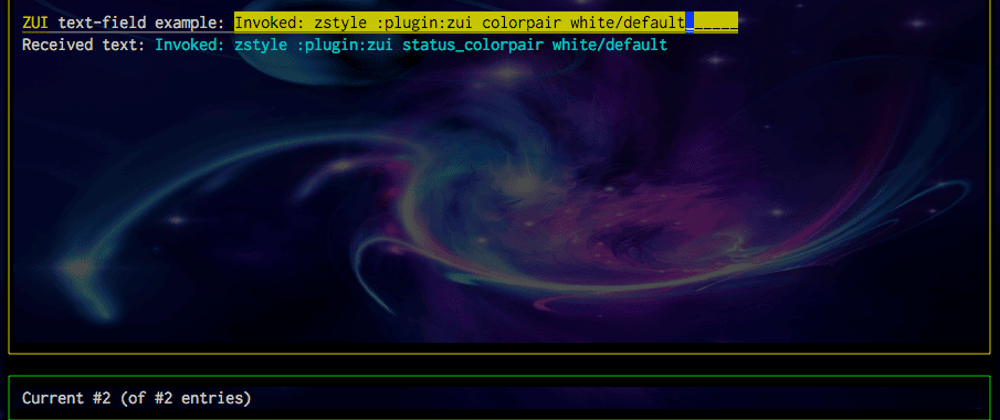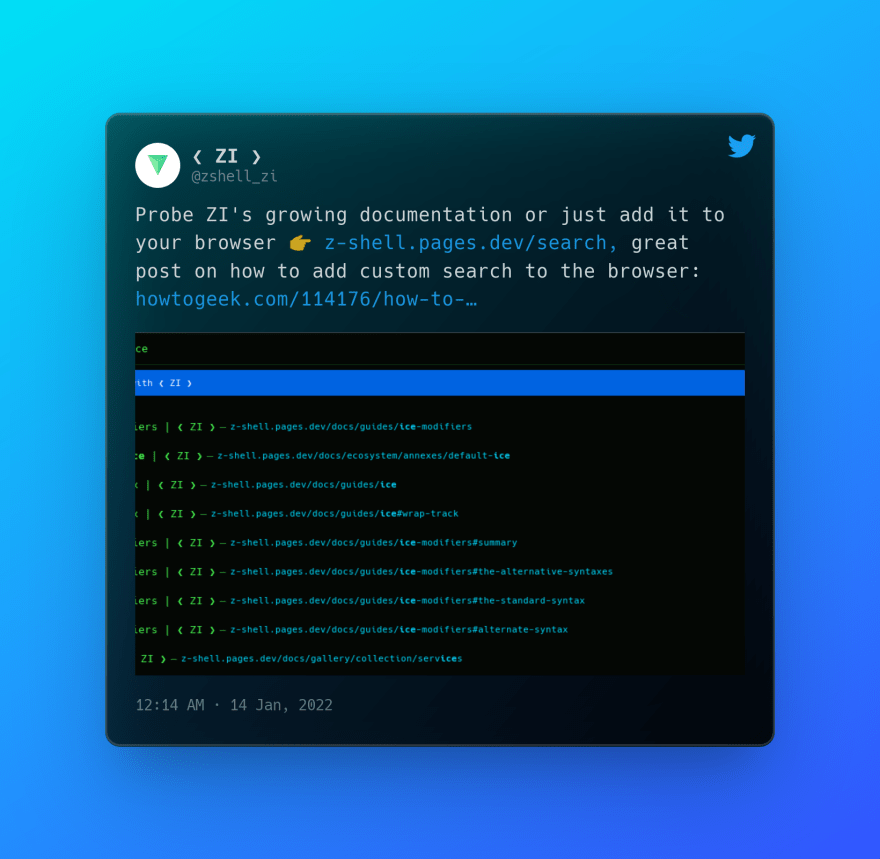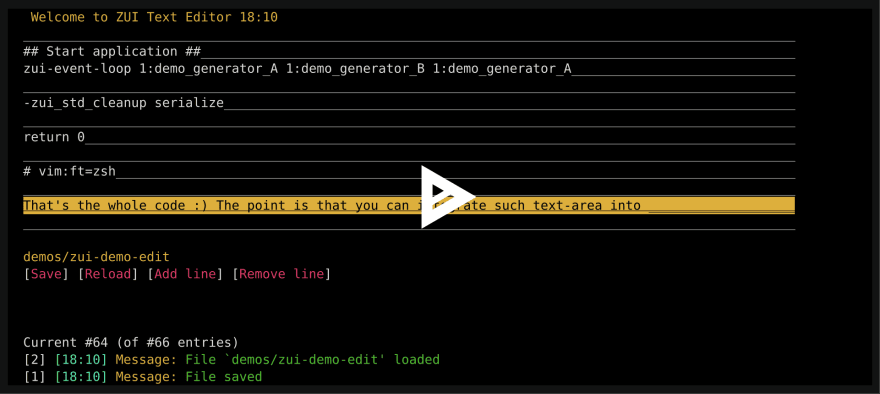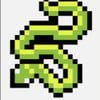❮ ZI ❯ is a fast and feature-rich plugin manager for Zsh / Unix shell.
⬢ ZUI is CGI+DHTML-like User Interface Library for Zsh / ZCurses
When setup both, I would say - quite strong combo.
❮ ZI ❯ has almost 100 repositories, also we initiating collaborations with China Dev's at Gitee.com/z-shell it extends the range of possibilities.
No limit not impressive? Well, then include almost all from here: https://github.com/unixorn/awesome-zsh-plugins as most are compatible :)
Repository: ZI, ZUI,
Issues reports: z-shell/zui
Open-Search Wiki: https://z.digitalclouds.dev/search
This is a RAD (Rapid Application Development) textual user interface library for Zsh. It in many aspects resembles typical CGI+(D)HTML setup. There are:
Generators ran on "server" side (basic Zshell-code that is just generating text!),
Event loop that turns the generated text into document with active elements (buttons, anchors, toggle buttons, text fields, list boxes),
Mechanism to regenerate document parts from the original generators.
So, a Zshell code generates text. It is then turned into document with hyperlinks. DHTML-like calls are possible that will regenerate document parts on the fly. Page can be also reloaded with input data, just like an HTML page. A voiced below or download file from google drive or watch youtube video at the end, that shows how to create an application – Nmap network scanner frontend.
Screenshots
Text-fields demo, showing what color "default" can do:
List-boxes demo:
History demo – fully functional history tool with incremental search:
Text Editor demo, written in 30 minutes:
Asciinema
Videos on the service Asciinema, where you can resize the video like a normal web page, and select/copy text.
List boxes, text fields:
Text editor written in 30 minutes:
Configure/Make wrapper:
Learning Zsh
ZUI will allow you to learn Zsh at advanced level. The library uses Zshell as e.g. Ruby. To write a functional program in Ruby, you need to know the language. To write a command or alias in Zsh, you can spend years not learning anything new. With ZUI you will learn how to use coproc, patterns with (#b) flag, Zstyles, arrays, hashes and various substitutions. That said, examples are there to make the process easy, and problems have easy and advanced way of solving.
API
The API consists of Standard Library, Utilities Library and Callbacks. You normally want few calls from Standard Library – to create buttons and regenerate document parts, and one or two callbacks. Fastest way to learn ZUI is to look at Hello World example and other example codes like the timeout example.
Standard Library
Standard Library contains functions to:
- initialize and cleanup an application,
- load and set application's configuration,
- create hyperlinks (buttons, anchors, text fields, list boxes),
- handle hyperlinks (e.g. check if given text is a hyperlink),
- control document regeneration on-the-fly (the DHTML-like way),
- handle modules (e.g. read module's position in document),
Calls of Standard Library
Below are descriptions of Standard Library functions. Arguments in triangular brackets are mandatory, in square brackets – optional.
-zui_std_init
-zui_std_init [app:"application ID"] [app_name:"Application name"]
Initializes application. To be called before emulate. Optional argument app:... will set ZUI[app] – hash field needed by any application. Argument app_name: does the same for ZUI[app_name] (it is a human-readable application name, displayed in header).
-zui_std_init2
-zui_std_init2
Initialization to be called after emulate. emulate is the command that makes a function an independent program and each ZUI application should use it.
-zui_std_stalog
-zui_std_stalog <Text 1> [Text 2] ...
Appends message to the status window logs. Each text argument has a color assigned – see the log_colors Zstyle, it controls the colors.
-zui_std_special_text
-zui_std_special_text <text> [output array]
reply+=( "{output string}" )
Quote special characters in text. This allows to use strings like That's in document – special character ' will not disturb content. Default output array is reply.
-zui_std_button_ext
-zui_std_button_ext <ID> <data1> <data2> <data3> <data4> <button text> [handler] [output array]
Creates string with button. Every button has an ID assigned – it is the first argument. Then go four user-data arguments – if handler will be invoked, the user-data will be passed to it along with the ID. <button text> is the label of the button. [handler] is the function name or inline code to be called at press of the button. [output array] name can be provided to have result appended to that array (the default array is reply). If handler has substring "internal" in it (in function name or in inline code), then it will be invoked without list restart. Otherwise, a list restart will be performed (this is like invoking JavaScript without web page reload, or doing the reload and calling code on the server side).
-zui_std_rc_button_ext
-zui_std_rc_button_ext <ID> <data1> <data2> <data3> <data4> <button text> [handler] [output array]
Function works identically to -zui_std_button, but it wraps button text in square brackets – "rc" is for "rectangular". Also, both functions have no-_ext versions that do not have <data1>...<data4> arguments.
-zui_std_anchor
-zui_std_anchor <ID> <index> <data1> <data2> <data3> <button text> [handler] [output array]
Creates an anchor – a hyperlink that moves cursor to specified line. Appends it to [output array] (a parameter specified by name) – reply by default. <index> is the line number to jump to. It is relative to current module. It in general cannot point to absolute line number in document. To point to line outside the module, use A+B syntax, e.g. 1-2, to jump 2 lines before first line of the module. Instead of handler you may use <data2> and <data3> to pass a module regeneration instruction. For example, pass ",mod2_ice1," "arg" to regenerate some module numbered 2, instance 1, with passed user-data "arg". This regeneration is with list restart (i.e. it is like web page reload with arg passed to script on the server side). If handler has substring "internal" in it (in function name or in inline code), then anchor will be internal – will not cause document reload. Anchor of which <data2> matches ,*, is set to be external. Example call:
-zui_std_anchor regen1 4 "" ",mod1_ice1," $RANDOM "[${ZUI[MAGENTA]}Regen${ZUI[FMT_END]}]"
This instructs to regenerate module 1 instance 1, with no handler call, with $RANDOM as generator's third input - regeneration user-data. 4 is the line number on which the cursor will be placed after the regeneration. Note that any generator call has instance ID (mod and ice) in $1 and $2 by the design of restart-regeneration loop.
-zui_std_text_field
-zui_std_text_field <ID> <width param> <index param> <text param> <data1> <data2> <data3> [handler] [output array]
Creates text-field. Every text-field has width, given in indirect way, by supplying name of variable holding the width number. In the same way start-index is to be provided – it specifies from which character the text should be displayed (so it can e.g. start from 5th character). <text param> is name of variable holding the string that the text-field contains. Handler will be called on accept event (i.e. Enter-press; Cancel is ESC-press, it restores previous text-field contents).
-zui_std_list_box
-zui_std_list_box <ID> <width param> <index param> <options param> <data1> <data2> <data3> [handler] [output array]
Creates list-box. Every list-box has a text-width that it will occupy in document regardless of option's text length. This width is specified via name of variable holding the width number. Current-selected option is <index param> – also a variable name. Options are specified by ;-separated string, put in a variable whose name is passed as fourth argument (<options param>). Handler will be called on accept event (i.e. Enter-press; Cancel is ESC-press, it restores previous list-box current option).
-zui_std_get_ganchor
-zui_std_get_ganchor <module index> <instance index> <button text>
Anchors cannot use global indexes and easily point to other modules. However, there are top anchors that point to each module. The top anchors can be hidden. However they are always accessible by this function. It fetches anchor pointing to module <module index>, instance <instance index>. The anchor will be having specified <button text>. You can use it as any other anchor, with the notable fact that handler cannot be specified, however a callback will be called on anchor's press: -zui-standard-global-anchors-callback(), with anchor's ID in $1, line number in $2, module index in $3, instance index in $4.
-zui_std_decode_hyperlink
-zui_std_decode_hyperlink <hyperlink string> [output array]
array=( ID data1 data2 data3 data4 )
Decodes given hyperlink (anchor, button, raw link). Its ID and user-data are placed in array given by name (default is reply array). Testable.
-zui_std_decode_text_field
-zui_std_decode_text_field <hyperlink string> [output array]
array=( ID width-param index-param text-param data1 data2 data3 )
Decodes given text-field hyperlink. Its ID, names of backend-parameters and user data are placed in array given by name (default is reply array). Testable.
-zui_std_decode_list_box
-zui_std_decode_list_box <hyperlink string> [output array]
array=( ID width-param index-param options-param data1 data2 data3 )
Decodes given list-box hyperlink. Its ID, names of backend-parameters and user data are placed in array given by name (default is reply array). Testable.
-zui_std_decode
-zui_std_decode <hyperlink string> [output parameter] [output array]
array=( {data decoded from hyperlink} )
parameter=1|2|3
Tries various decoding functions (for regular hyperlinks, text-fields, list-boxes). Testable. Returns (in REPLY or specified parameter) 1 if recognized regular hyperlink (anchor, button, raw link), 2 if text field, 3 if list-box. Will return 0 for unrecognized string, however the function is testable so normal return value test can be performed.
-zui_std_get_stext
-zui_std_get_stext <special-text string> [output parameter]
REPLY={text}
Output variable (default: REPLY) is set to text contained in the special-text string.
-zui_std_is_hyperlink
-zui_std_is_hyperlink <hyperlink string>
Checks if given string is a regular hyperlink (anchor, button, raw link). Testable (true – the string is a correct hyperlink).
-zui_std_is_text_field
-zui_std_is_text_field <hyperlink string>
Checks if given string is a text-field. Testable (true – the string is a correct text-field).
-zui_std_is_list_box
-zui_std_is_list_box <hyperlink string>
Checks if given string is a list-box. Testable (true – the string is a correct list-box).
-zui_std_is_any_hyperlink
-zui_std_is_any_hyperlink <hyperlink string> [output parameter]
parameter=1|2|3
Checks if given string is any possible hyperlink, from anchor to list-box. Output parameter (REPLY by default) will contain 1 if recognized regular hyperlink, 2 if text-field, 3 if list-box. For unrecognized string it will contain 0, however the function is testable, so a regular return value check can be performed.
-zui_std_has_any_hyperlinks
-zui_std_has_any_hyperlinks <hyperlink string>
Similar to -zui_std_is_any_hyperlink, but doesn't return type of the hyperlink recognized. Testable.
-zui_std_load_config
-zui_std_load_config <variable> <default> <time limit> <output parameter>
Loads variable from configuration if it's older than e.g. 2 seconds (the <time limit> argument). Time limit is used only if <output parameter> points to ZUI hash field, e.g. ZUI[text_mode]. Otherwise the configuration is always read regardless of time limit. <variable> should have b: prefix for boolean type, s: for string type (s: is the default). Boolean variables are mapped to just 0 or 1, the same only values are accepted as <default> value for that variable type. Example call:
-zui_std_load_config s:text_mode "off" 2 'ZUI[text_mode]' # No text-segment navigation
The Zstyle variable is looked up at path :plugin:zui, then at :plugin:zui:app:${ZUI[app]}. The latter path has higher priority.
-zui_std_store_default_app_config
-zui_std_store_default_app_config <variable> <value>
Stores given variable to Zstyle if the variable is not already set. Can be used to set up default configuration of application. User will be still able to set his own configuration, the function will not overwrite it. Example call:
-zui_std_store_default_app_config b:top_anchors 0 # No top-anchors
-zui_std_cleanup
-zui_std_cleanup [serialize|deserialize:"app"]
Clears the ZUI hash – all configuration fields, anchors, buttons, etc. Also, clears fields that start with my_ – this is the provided namespace to use by applications. If serialize given, will store my_* fields and zui-list state fields into special ZUI field. It can be then retrieved by deserialize:"app" – effect will be like if the application was never left.
-zui_std_set_mod_factor
-zui_std_set_mod_factor <module index> <factor>
Sets how many instances of module given by index should be generated (the module-factor).
-zui_std_get_mod_factor
-zui_std_get_mod_factor <module index> [output parameter]
Gets number of instances of module given by index. Stores result in REPLY, or in other parameter specified by name.
-zui_std_load_global_index_and_size
-zui_std_load_global_index_and_size <module index> <instance index> [output param1] [output param2]
Loads where module is located (at which line in document) and what size it has (how many lines it occupies). Stores to REPLY and REPLY2 by default, or to specified parameters.
-zui_std_reset_replies
-zui_std_reset_replies
Generators use parameters reply, reply2, reply3, reply4. This functions clears them.
-zui_std_map_replies
-zui_std_map_replies
Generator output should be mapped onto parameters:
mod${midx}_ice${iidx}_output
mod${midx}_ice${iidx}_size
mod${midx}_ice${iidx}_nonselectables
mod${midx}_ice${iidx}_hops
mod${midx}_ice${iidx}_anchors
This function does this. It should normally not be needed, -zui_std_fly_mod_regen does this automatically.
-zui_std_fly_mod_regen
-zui_std_fly_mod_regen <module index> <instance index>
Schedules on-the-fly document-fragment update. This corresponds to DHTML, to doing document.getElementById('...').innerHtml=.... No list restart is required (no "page reload"). Arguments <module index> and <instance index> specify which module instance should be regenerated. The generator used to obtain new content is taken from zui-event-loop list (see -zui_std_fly_array_refresh) and depends only on <module index>. In other words, the same generator is used, the one normally assigned to module instance.
-zui_std_fly_mod_regen_ext
-zui_std_fly_mod_regen <generator> <module index> <instance index>
The same as -zui_std_fly_mod_regen, but uses alternate, specified generator-function.
-zui_std_fly_array_refresh
-zui_std_fly_array_refresh <module index>
Submits on-the-fly array refresh. The given <module index> should point to an array ("a:" prefix at zui-event-loop). The array will be read again and pasted into document replacing previous content. For example, in the history demo there is:
zui-event-loop 1:demo_generator_A a:u-history 1:demo_generator_A
Second module (and 1st instance) is array history that is made unique (the u- prefix). You can refresh that content (document fragment) via:
-zui_std_fly_array_refresh 2
Utilities Library
Standard Library contains functions to:
- automate toggle buttons,
- strip color codes from text,
- etc.
Calls of Utilities Library
Below are descriptions of Utilities Library functions. Arguments in triangular brackets are mandatory, in square brackets – optional.
-zui_util_map_bools
-zui_util_map_bools <expressions> <parameters> <true string> <false string>
Maps boolean values of expressions given in $1 (string with entries separated by ';') to parameters given via names in $2 (separated by ';'). For true, <true string> is assigned to corresponding parameter, <false string> for false. Example call:
local color1 color2 color3
-zui_util_map_bools "1;[[ a = b ]];ZUI[text_select]" "color1;color2;color3" $red $white
Parameter color1 will be set to $red, color2 to $white, color3 will be assigned depending on $ZUI[text_select] value. Use this to automate toggle buttons – highlight the buttons with one of two colors, depending on state of a backend variable.
-zui_util_strip_codes
-zui_util_strip_codes <text>
Strips formatting codes from text in, saves result into parameter REPLY.
-zui_util_get_time
-zui_util_get_time
REPLY="H:M time string"
Returns time in format %H:%M, via datetime module (fast) or date command as fallback
-zui_util_get_datetime
-zui_util_get_datetime
REPLY="Ymd_H.M.S date string"
Returns date and time. Uses datetime zsh module (fast) or date command as fallback.
-zui_util_get_timestamp
-zui_util_get_timestamp
REPLY={seconds}
Returns timestamp, via datetime module (fast) or date as a fallback.
-zui_util_has_default_color
-zui_util_has_default_color
Returns true if the "default" color can be used with current Zsh/zcurses.
-zui_util_resolve_path
-zui_util_resolve_path <current working directory> <file path>
reply[1]={dir-name}
reply[2]={base-name}
Resolves absolute path to file from <current working directory> and <file path>. Returns the path as two components, dir-name in reply[1], base-name in reply[2].
-zui_util_to_cmd_line
-zui_util_to_cmd_line <text>
Puts given text on command line - regardless of Zle being active or not
-zui_util_circular_next
-zui_util_circular_next <base> <size>
REPLY={path}
Returns next file to write to in circular buffer set of file names <base>.1 <base>.2 ... <base>.<size>. The buffer is ordered according to modification time – oldest file from the set is the returned one (so after write the circular buffer updates). Files are located in ~/.config/zui/var/circular_buffers.
-zui_util_circular_paths
-zui_util_circular_paths <base>
reply=( {path1} {path2} ... )
Returns absolute file paths of given circular buffer. The paths are ordered from most recent to least recent. No count is obtained, so all files are returned, even actually disabled by any used <size> (with -zui_util_circular_next).
Callbacks
Many situations are solved by callbacks. This eases the API, you don't have to e.g. supply a
function name in a call but instead just define a function. Callback names follow scheme -zui-standard-*-callback. They are automatically cleared at cleanup (i.e. at -zui_std_cleanup call).
-zui-standard-timeout-callback
-zui-standard-timeout-callback
Called when $ZUI[timeout] milliseconds pass without user input (the timeout defaults to -1, i.e. no timeout defined). No arguments, and the return value is not checked. Redraw of screen might be invoked by setting $ZUI[timeout_update] to 1. Regeneration of module can be scheduled by invoking -zui_std_fly_mod_regen, this implies setting $ZUI[timeout_update]. $ZUI[timeout] is a Zstyle of the same name.
zui-demo-timeout covers this callback.
-zui-standard-text-select-callback
-zui-standard-text-select-callback <type> <text>
Called when a text is selected. This is possible when Zstyle text_select is 1. The Zstyle text_mode can be off – only whole lines can be then selected. <type> is then set to string line. If text_mode is hyp, then text-segments at lines with hyperlinks can be selected. When it is nohyp then this applies to lines without hyperlinks. Value all allows selection of text segments at all lines, with or without hyperlinks. If a text-segment is selected, <type> is set to string segment.
-zui-standard-global-anchors-callback
-zui-standard-global-anchors-callback <id> <initial line> <module index> <instance index>
Invoked when a global-anchor is pressed. Global anchors are typically at first line of document, controlled by Zstyle top_anchors. First argument <id> is the ID of the anchor button, in format aglobal_m<module-index>_i<instance-index>. Second argument <initial line> is set to destination line used when creating the anchor – it might have been changed by dynamic updates to document, i.e. module-regeneration that shifts target lines up or down. <module index> and <instance index> specify to which module-instance the anchor is jumping to.
-zui-standard-status-callback
-zui-standard-status-callback 0 <selectable> <uniq> <search> <line> <segment>
-zui-standard-status-callback 1 <selectable> <uniq> <search> <line> <segment> ...
Called after each key-press and also when timeout-callback schedules document update – $ZUI[timeout_update] is then 1. First argument can be 0 or 1 and it is the type of active segment – 0 is case: no-hyperlink-active. <selectable> / <uniq> / <search> are 0 or 1 and denote if current line is selectable / if uniq mode is enabled / if there is a search query entered. Arguments <line> and <segment> are current line and segment.
For variant with 1 in first argument, what follows is current-hyperlink decoded data. For anchors and buttons, it is (follows code to be used to read the input):
local id="$7" data1="$8" data2="$9" data3="$10" data4="$11"
For text-fields, it is:
local id="$7" width="$8" index="$9" text="$10" data1="$11" data2="$12" data3="$13"
For list-boxes, it is:
local id="$7" width="$8" index="$9" options_text="$10" data1="$11" data2="$12" data3="$13"
You can test for tfield in ID of a text-field, and for lbox in ID of a list-box. These strings are prepended to the IDs that you use when creating those hyperlinks. You can then read the whole data as follows:
local tpe="$1" selectable="$2" uniq="$3" search="$4" line="$5" segment="$6"
shift 6
[[ "$1" = *(tfield|lbox)* ]] && local id="$1" width="$2" index="$3" text="$4" data1="$5" data2="$6" data3="$7" ||
local id="$1" data1="$2" data2="$3" data3="$4" data4="$5"
Main function of status callback is adding message to status window. It should return 1 and set array reply to add the message. For example:
reply=( "My " "new " "message" )
return 1
Returning 0 means not-updating status window, and reply is then ignored.
Zstyles
To change ZUI global default, invoke:
zstyle ":plugin:zui" colorpair "white/black"
An application may override such default with its own default. To change default per-application, invoke:
zstyle ":plugin:zui:app:zui-demo-fly" colorpair "250/17" # 256 colors – zsh >= 5.3; "default" color also from this version
Below is complete list of available Zstyles with ZUI default values.
| ZStyle name | Default | Description |
|---|---|---|
| "colorpair | "white/black" | Default text and background color. For Zsh >= 5.3, color "default" is available, it might be e.g. transparent (depends on terminal configuration) |
| border | "no" | No border around main window |
| border_cp | "yellow/black" | Border (and header) color |
| bold | "no" | No default bold |
| status_colorpair | "white/black" | The same as "colorpair", but for status window |
| status_border | "no" | No border around status window |
| status_border_cp | "green/black" | Border color of status window |
| status_bold | "no" | No default bold in status window |
| mark | "red reverse lineund" | String starting with one or two color names continued with combination of: reverse, underline, blink, bold, lineund, linerev. Last two underline, reverse whole active line. The rest mark active button. Uppercase color names are for background |
| altmark | "red reverse" | As "mark", but for terminals without underline support |
| mark2 | "yellow reverse" | The same as "mark", but for buttons with background color |
| altmark2 | "yellow reverse" | The same as "altmark", but for "mark2", i.e. mark for buttons with background color, on terminals with no underline support |
| status_size | 4 | Height of status window, including border (drawn or not) |
| status_pointer | "yes" | Show line indicating position in document |
| log_append | "above" | Put log messages on top of others. Also available: "below" |
| log_time_format | "[%H:%M] " | Display hour:minute time stamp. Set to "" to disable time stamp completely |
| log_index | "yes" | Show order number of log messages |
| log_size | "32" | How many log messages to keep in memory |
| top_anchors | "yes" | Show anchors to each module instance at top |
| log_colors | "white cyan yellow green cyan red magenta yellow blue" | The colors used for log messages. First two are for message's index and time stamp |
| select_mode | "no-restart" | What to do on non-hyperlink selection. Such selection will invoke text-select callback with segment or whole line passed as argument. Plus, it will set ZUI[line_selected] or ZUI[pure_text_selected]. If the Zstyle is set to "restart" then list restart will be performed. If set to "quit" then event loop will be exited, and REPLY will be set to line or segment. |
| text_mode | "all" | Navigate across each bit of text, not only hyperlinks. "hyp" – only at lines with hyperlinks, "nohyp" – only at lines with no hyperlinks, "off" - text-bit navigation fully turned off |
| text_select | "yes" | Allow selection on non-hyperlinks (full lines when text_mode is "off" or "hyp" – meaning text-bit mode fully turned off or enabled only for lines with hyperlinks, leaving text-only lines undivided) |
| timeout | "-1" | No calls to timeout callback. Denotes milliseconds. Minimum value is 200. Time is counted when there is no user input |
| palette | "black:red:green: yellow:blue:magenta: cyan:white" | 8-color palette used by ZUI. Default is normal ANSI palette. Can be changed to indexes of 256 colors (zsh >= 5.3)" |
All Zstyles are available in ZUI repository: Zstyles
Example - Hello World
# Started from Zle or from command line
-zui_std_cleanup deserialize:"zui-demo-hello-world"
-zui_std_init app:"zui-demo-hello-world" app_name:"ZUI Hello World"
emulate -LR zsh -o extendedglob -o typesetsilent -o warncreateglobal
-zui_std_init2 # after emulate -LR
-zui_std_store_default_app_config b:border 1
demo_generator_A() {
local mod="$1" ice="$2"
# Content, no hyper-links
reply=( "Hello World from ${ZUI[YELLOW]}ZUI${ZUI[FMT_END]}! Module $mod, instance $ice." )
# Non-selectable lines Hops to jump with [ and ] Local anchors
reply2=( ) reply3=( 1 ) reply4=( )
}
## Start application ##
zui-event-loop 1:demo_generator_A
-zui_std_cleanup serialize
Other example which uses list-box: zui-demo-list-box.
ZUI Installation
The plugin is "standalone", which means that only sourcing it is needed. So to install, unpack zui somewhere and add
source {where-zui-is}/zui.plugin.zsh
to zshrc.
If using a plugin manager, then ZI is recommended, but you can use any other too, and also install with Oh My Zsh (by copying directory to ~/.oh-my-zsh/custom/plugins).
ZUI - ZI
Add zi load z-shell/zui to your .zshrc file. ZI will handle the rest automatically the next time you start zsh. To update (i.e. to pull from origin) issue zi update z-shell/zui.
ZUI - Antigen
Add antigen bundle z-shell/zui to your .zshrc file. Antigen will handle cloning the plugin for you automatically the next time you start zsh.
ZUI - Oh-My-Zsh
cd ~/.oh-my-zsh/custom/pluginsgit clone git@github.com:z-shell/zui.git- Add
zuito your plugin list
ZUI - Zgen
Add zgen load z-shell/zui to your .zshrc file in the same place you're doing your other zgen load calls in.
Video tutorial:
P.S: Your English not that good as you expect :D


















Oldest comments (0)